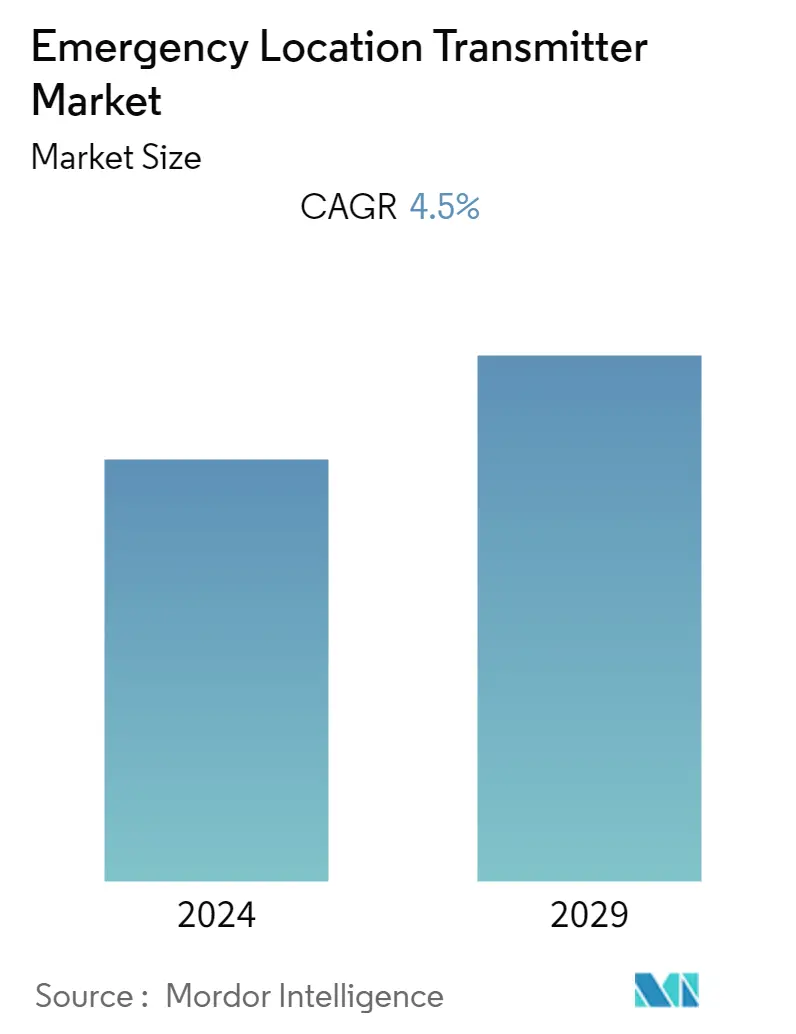
| Study Period | 2019 - 2029 |
| Base Year For Estimation | 2023 |
| Forecast Data Period | 2024 - 2029 |
| Historical Data Period | 2019 - 2022 |
| CAGR | 4.50 % |
| Fastest Growing Market | Asia Pacific |
| Largest Market | North America |
Major Players
*Disclaimer: Major Players sorted in no particular order |
Emergency Location Transmitter Market Analysis
The Emergency Location Transmitter Market was valued at USD 149.74 million in 2020 and is expected to reach USD 194.82 million by 2026 and grow at a CAGR of 4.5% over the forecast period (2021-2026). The growth of ELTs was primarily driven by various regulations introduced around the world. Countries like the United States, France, and the United Kingdom were among the first ones to make the installation of ELTs mandatory in several aviation and transportation practices. The globally accepted frequency for ELTs has been set to 406 MHz since 2009. Most countries shifted to this frequency in the early years, but a large part of the developing countries and countries with low penetration of ELT devices still lack such concepts. Reportedly, Mexico was the last country to shift to 406 MHz in December 2018.
- The most significant impact of ELTs is noticed in the rescue operations conducted worldwide. Earlier, it used to take hours to get notified of any incident and the rescue operators had to sweep the suspected area manually, consuming critical time required to attend to the victims. Various regulatory authorities now mandate it in different countries for planes flying in their airspace to be equipped with ELTs for safety purposes. The major aircraft that use these devices include lightweight aircraft, passenger aircraft, and defense aircraft, which constitute a major portion of the world's active air fleet.
- The market for ELTs witnessed a shift from 121.5 MHz ELTs to 406 MHz. For instance, in April 2011, the Federal Communications Commission (FCC) elected to stay a proposed rule that mandated the replacement of 121.5 MHz emergency locator transmitters (ELTs) with 406 MHz ELTs. On March 29, the FCC published a final rule that indefinitely stays its original order regarding ELTs. Such regulations have supported the adoption of 406 MHz ELTs over 121.5 MHz.
- Furthermore, the regular maintenance activities include changing the battery, calibrating the GPS, and inspecting for damages caused by wear and tear factors. If not maintained appropriately, the ELT may not get triggered during an incident or may send false alarms, which attracts enormous fines. Operators tend to replace their ELTs after a specific duration to avoid such events, which is driving the demand for more robust and reliable ELTs.
- ELTs are a minimal component in an aircraft, enabling great safety features. Owing to the benefits offered by this technology, there is a continuous innovation in this domain to make ELTs more compact and highly reliable. Companies, like Orolia, are continually bringing new solutions to the market. Recently, two new next-gen ELTs were launched at the Paris Air Show held in June 2019. Similarly, the marine industry benefited immensely from ELTs. Applications making use of ELTs include offshore oil rigs, cargo vessels, fishing vessels, and other special-purpose recreation boats.
- The ELTs pose significant challenges, such as the inadvertent activation of ELT systems is a serious problem that expends resources and can divert equipment and manpower away from real emergencies. Furthermore, high false alarm rates can desensitize response teams, as they may think the event is not real. While all ELT activations trigger a response from emergency response teams, only a small fraction are real emergencies. Such instances are anticipated to impact the market.
Emergency Location Transmitter Industry Segmentation
Emergency location transmitter (ELT) is a piece of equipment that broadcasts different signals on designated frequencies, and depending upon the application, it can automatically activate itself, in case of an impact, or can be manually activated by the user.
| Aerospace Applications (Commercial and Defense) |
| Maritime Applications |
| Personal Applications |
| North America |
| Europe |
| Asia-Pacific |
| Latin America |
| Middle East and Africa |
Emergency Location Transmitter Market Size Summary
The emergency location transmitter (ELT) market is experiencing growth driven by regulatory mandates and technological advancements. The shift from 121.5 MHz to 406 MHz ELTs has been a significant trend, with countries like the United States, France, and the United Kingdom leading the way in making these devices mandatory for aviation and transportation safety. The adoption of 406 MHz ELTs is particularly notable due to their enhanced reliability and ability to transmit coded digital information, which improves response times during emergencies. The market is characterized by continuous innovation, with companies like Orolia and Honeywell introducing next-generation solutions to enhance the compactness and reliability of ELTs. These devices are crucial in rescue operations, significantly reducing the time taken to locate and assist victims in emergencies.
North America is expected to dominate the ELT market, largely due to the robust aviation network in the United States and the high demand for general aviation aircraft. The region's regulatory framework mandates the installation of ELTs on aircraft, further driving market growth. The recreational boating sector also contributes to the demand for ELTs, with a notable increase in powerboat sales. The market is moderately competitive, with key players such as Honeywell International Inc., Orolia Holding SAS, and Astronics Corporation focusing on product innovation and strategic partnerships to enhance their market presence. These companies are actively developing solutions that integrate advanced technologies to meet the evolving needs of the aviation and maritime industries.
Emergency Location Transmitter Market Size - Table of Contents
1. MARKET DYNAMICS
- 1.1 Market Overview
- 1.2 Industry Value Chain Analysis
-
1.3 Industry Attractiveness - Porter's Five Forces Analysis
- 1.3.1 Bargaining Power of Suppliers
- 1.3.2 Bargaining Power of Consumers
- 1.3.3 Threat of New Entrants
- 1.3.4 Threat of Substitutes
- 1.3.5 Intensity of Competitive Rivalry
-
1.4 Market Drivers
- 1.4.1 Increasing Aviation/Maritime Disasters
-
1.5 Market Restraints
- 1.5.1 Government Regulations and Policies on the Standards to be Maintained on the Devices
- 1.6 Assessment of Impact of Covid-19 on the Industry
2. MARKET SEGMENTATION
-
2.1 End-user Vertical
- 2.1.1 Aerospace Applications (Commercial and Defense)
- 2.1.2 Maritime Applications
- 2.1.3 Personal Applications
-
2.2 Geography
- 2.2.1 North America
- 2.2.2 Europe
- 2.2.3 Asia-Pacific
- 2.2.4 Latin America
- 2.2.5 Middle East and Africa
Emergency Location Transmitter Market Research FAQs
What is the current Emergency Location Transmitter Market size?
The Emergency Location Transmitter Market is projected to register a CAGR of 4.5% during the forecast period (2025-2030)
Who are the key players in Emergency Location Transmitter Market?
Honeywell International Inc., Orolia Holding SAS, ECA Group, Astronics Corporation and Ack Avionics Technologies Inc. are the major companies operating in the Emergency Location Transmitter Market.


